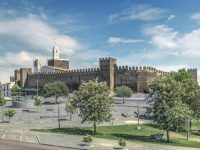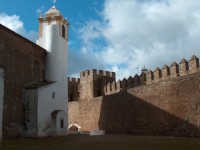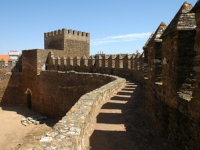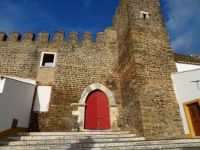Background
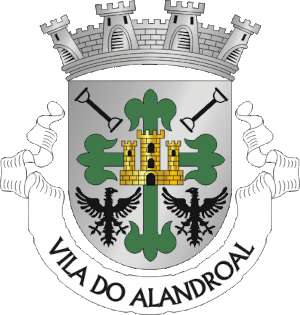
This medieval fortress is a typical Gothic fortification, with a generally oval plan, with a keep attached to the fence and the main gate, the so-called Porta Legal, protected by two quadrangular towers, slightly advanced to allow a greater vertical firing range over the entrance.
Originally, the castle was part of a small neighbourhood within the walled area, whose urban layout consisted of a single road - Rua do Castelo - running west-east, and flanked by two gates, the aforementioned main gate, or Legal, and the Arrabalde gate.
The medieval castle

Built during the reign of Denis of Portugal (1279-1325), according to the epigraphic inscription on one of the doors, its first stone was laid on February 6, 1294 by D.Lourenço Afonso, Master of the Military Order of Aviz. A second inscription, on the west elevation of the Keep Tower (now part of the Treasury Room of the Main Church), informs of the completion of its construction on 24 February 1298, with the same D.Lourenço Afonso as Master of the Order. A third inscription, on the tower to the right of the main gate, critically dated between 1294 and 1298, refers to the name of its builder, who identified himself only as "I, Mouro Galvo".
Alandroal was elevated to the status of town by a Charter of 1486, granted by John II of Portugal (1481-1495). In this capacity, during the reign of his nephew and successor, Manuel I of Portugal (1495-1521), the town and its castle are depicted by Duarte de Armas (Book of Fortresses, c. 1509).
From the 17th century to the present day

By 1606, most of the buildings within the enclosure were ruined. In the 18th century, the complex lost its Barbican, which was demolished to make way for the new Town Hall and County Jail buildings inside the walls.
Considered a National Monument by Decree of 16 June 1910, it was only in the 1940s that consolidation and restoration work was carried out, mainly the reconstruction of some sections of the walls and the clearing of the structure of numerous houses that, over the centuries, had been attached to the walls.
Features
Em estilo gótico, o castelo apresenta planta oval (na qual se inscreve um pequeno bairro intra-muros), reforçada por três torres de planta quadrangular, nos ângulos, e uma sólida Torre de Menagem adossada à cerca. O portão principal (Porta Legal) é ladeado por duas torres quadrangulares, ligeiramente avançadas (para permitir o tiro vertical sobre a entrada), ligados por uma cortina e encimadas por ameias de remate piramidal.
A Torre de Menagem, de planta quadrangular, divide-se internamente em três pavimentos. O acesso ao seu interior encontra-se, atualmente, entaipado. A esta torre, adossou-se, ainda no século XIII, a Igreja de Nossa Senhora da Graça, que alterada posteriormente, hoje apresenta traços renascentistas, patentes particularmente na abóbada artesoada. Em 1744, o terraço da Igreja foi aproveitado para edificar a Torre do Relógio.
The castle, in a dominant position, was associated with the town's surroundings, with very simple urban planning, with a single road (Castle Street) running east-west, flanked by two gates. The main one, called Porta Legal, to the east, through which the churchyard is accessed, is made up of a Gothic arch with a corridor, flanked by two quadrangular Turrets connected by a curtain and topped by Battlements with a pyramidal finish. The only street that crosses the town starts from here and ends at the so-called Porta do Arrabalde, to the west, with marble loopholes and also flanked by a tower, where the "vara" (a standard measurement at the time) was engraved on its ceiling height, on the outside, for measuring the measurements used in local commerce.
Scholars also point out, as identifying marks of the Islamic cultural background of its builder, in addition to the previously mentioned epigraphy, a horseshoe-shaped window in one of the towers and similarities between the tower system of this castle and the Almohad walls of Seville.
Events of the time
1267 - Signing of the Treaty of Badajoz, which establishes the borders
between Portugal and Castile.
1270 - End of the Eighth crusade.
- Donation of the Lordship of Portalegre, Marvão, Arronches and Vide
to Afonso de Portugal,
brother of Denis of Portugal">D.
Denis.
1273 - Foundation of the city of Montalegre, in Portugal.
1275 - The Venetian Marco Polo
arrives in Beijing, China.
1278 - Afonso III of Portugal">Afonso III of Portugal hands over the government of
the kingdom to D.Denis.
- Independence of Andorra.
1279 - Denis of Portugal becomes king of Portugal.
- The first references to the Azores archipelago originate from sea
voyages made by Europeans in the 14th century,
namely from Portugal during the reigns of Denis of
Portugal (1279-1325) and his successor,
Afonso IV.
- In Portugal, King Denis of
Portugal begins the process of requalifying the
walls of Braga. The works will continue until around 1325.
1281 - Beginning of the armed struggle between Denis of
Portugal">Denis of Portugal and the
infante D.Afonso, his brother.
- Denis of Portugal offered the town of Monforte
to his daughter
D.Isabel as a dowry at
her wedding.
1282 - June 26 - Wedding, in Trancoso, of Denis of
Portugal, King of Portugal and
Isabel of Aragon.
- Agreement between Denis of
Portugal and his brother Afonso, in Badajoz.
Afonso promises to destroy the walls he had built, be knighted and become his vassal.
1290 - Em Portugal, Denis of
Portugal">Denis of Portugal
atribuiu Foral a
Ourique.
